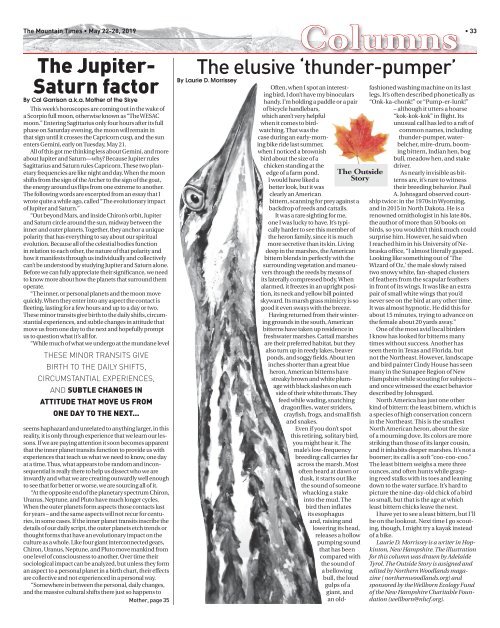Mountain Times - Volume 48, Number 21: May 22-28, 2019
You also want an ePaper? Increase the reach of your titles
YUMPU automatically turns print PDFs into web optimized ePapers that Google loves.
Columns<br />
The <strong>Mountain</strong> <strong>Times</strong> • <strong>May</strong> <strong>22</strong>-<strong>28</strong>, <strong>2019</strong> • 33<br />
The Jupiter-<br />
Saturn factor<br />
By Cal Garrison a.k.a. Mother of the Skye<br />
This week’s horoscopes are coming out in the wake of<br />
a Scorpio full moon, otherwise known as “The WESAC<br />
moon.” Entering Sagittarius only four hours after its full<br />
phase on Saturday evening, the moon will remain in<br />
that sign until it crosses the Capricorn cusp, and the sun<br />
enters Gemini, early on Tuesday, <strong>May</strong> <strong>21</strong>.<br />
All of this got me thinking less about Gemini, and more<br />
about Jupiter and Saturn—why? Because Jupiter rules<br />
Sagittarius and Saturn rules Capricorn. These two planetary<br />
frequencies are like night and day. When the moon<br />
shifts from the sign of the Archer to the sign of the goat,<br />
the energy around us flips from one extreme to another.<br />
The following words are excerpted from an essay that I<br />
wrote quite a while ago, called “The evolutionary impact<br />
of Jupiter and Saturn.”<br />
“Out beyond Mars, and inside Chiron’s orbit, Jupiter<br />
and Saturn circle around the sun, midway between the<br />
inner and outer planets. Together, they anchor a unique<br />
polarity that has everything to say about our spiritual<br />
evolution. Because all of the celestial bodies function<br />
in relation to each other, the nature of that polarity and<br />
how it manifests through us individually and collectively<br />
can’t be understood by studying Jupiter and Saturn alone.<br />
Before we can fully appreciate their significance, we need<br />
to know more about how the planets that surround them<br />
operate.<br />
“The inner, or personal planets and the moon move<br />
quickly. When they enter into any aspect the contact is<br />
fleeting, lasting for a few hours and up to a day or two.<br />
These minor transits give birth to the daily shifts, circumstantial<br />
experiences, and subtle changes in attitude that<br />
move us from one day to the next and hopefully prompt<br />
us to question what it’s all for.<br />
“While much of what we undergo at the mundane level<br />
THESE MINOR TRANSITS GIVE<br />
BIRTH TO THE DAILY SHIFTS,<br />
CIRCUMSTANTIAL EXPERIENCES,<br />
AND SUBTLE CHANGES IN<br />
ATTITUDE THAT MOVE US FROM<br />
ONE DAY TO THE NEXT...<br />
seems haphazard and unrelated to anything larger, in this<br />
reality, it is only through experience that we learn our lessons.<br />
If we are paying attention it soon becomes apparent<br />
that the inner planet transits function to provide us with<br />
experiences that teach us what we need to know, one day<br />
at a time. Thus, what appears to be random and inconsequential<br />
is really there to help us dissect who we are<br />
inwardly and what we are creating outwardly well enough<br />
to see that for better or worse, we are sourcing all of it.<br />
“At the opposite end of the planetary spectrum Chiron,<br />
Uranus, Neptune, and Pluto have much longer cycles.<br />
When the outer planets form aspects those contacts last<br />
for years – and the same aspects will not recur for centuries,<br />
in some cases. If the inner planet transits inscribe the<br />
details of our daily script, the outer planets etch trends or<br />
thought forms that have an evolutionary impact on the<br />
culture as a whole. Like four giant interconnected gears,<br />
Chiron, Uranus, Neptune, and Pluto move mankind from<br />
one level of consciousness to another. Over time their<br />
sociological impact can be analyzed, but unless they form<br />
an aspect to a personal planet in a birth chart, their effects<br />
are collective and not experienced in a personal way.<br />
“Somewhere in between the personal, daily changes,<br />
and the massive cultural shifts there just so happens to<br />
Mother, page 35<br />
The elusive ‘thunder-pumper’<br />
By Laurie D. Morrissey<br />
Often, when I spot an interesting<br />
bird, I don’t have my binoculars<br />
handy. I’m holding a paddle or a pair<br />
of bicycle handlebars,<br />
which aren’t very helpful<br />
when it comes to birdwatching.<br />
That was the<br />
case during an early-morning<br />
bike ride last summer,<br />
when I noticed a brownish<br />
bird about the size of a<br />
The Outside<br />
Story<br />
chicken standing at the<br />
edge of a farm pond.<br />
I would have liked a<br />
better look, but it was<br />
clearly an American<br />
bittern, scanning for prey against a<br />
backdrop of reeds and cattails.<br />
It was a rare sighting for me,<br />
one I was lucky to have. It’s typically<br />
harder to see this member of<br />
the heron family, since it is much<br />
more secretive than its kin. Living<br />
deep in the marshes, the American<br />
bittern blends in perfectly with the<br />
surrounding vegetation and maneuvers<br />
through the reeds by means of<br />
its laterally compressed body. When<br />
alarmed, it freezes in an upright position,<br />
its neck and yellow bill pointed<br />
skyward. Its marsh grass mimicry is so<br />
good it even sways with the breeze.<br />
Having returned from their wintering<br />
grounds in the south, American<br />
bitterns have taken up residence in<br />
freshwater marshes. Cattail marshes<br />
are their preferred habitat, but they<br />
also turn up in reedy lakes, beaver<br />
ponds, and soggy fields. About ten<br />
inches shorter than a great blue<br />
heron, American bitterns have<br />
streaky brown and white plumage<br />
with black slashes on each<br />
side of their white throats. They<br />
feed while wading, snatching<br />
dragonflies, water striders,<br />
crayfish, frogs, and small fish<br />
and snakes.<br />
Even if you don’t spot<br />
this retiring, solitary bird,<br />
you might hear it. The<br />
male’s low-frequency<br />
breeding call carries far<br />
across the marsh. Most<br />
often heard at dawn or<br />
dusk, it starts out like<br />
the sound of someone<br />
whacking a stake<br />
into the mud. The<br />
bird then inflates<br />
its esophagus<br />
and, raising and<br />
lowering its head,<br />
releases a hollow<br />
pumping sound<br />
that has been<br />
compared with<br />
the sound of<br />
a bellowing<br />
bull, the loud<br />
gulps of a<br />
giant, and<br />
an oldfashioned<br />
washing machine on its last<br />
legs. It’s often described phonetically as<br />
“Onk-ka-chonk!” or “Pump-er-lunk!”<br />
– although it utters a hoarse<br />
“kok-kok-kok” in flight. Its<br />
unusual call has led to a raft of<br />
common names, including<br />
thunder-pumper, waterbelcher,<br />
mire-drum, booming<br />
bittern, Indian hen, bog<br />
bull, meadow hen, and stake<br />
driver.<br />
As nearly invisible as bitterns<br />
are, it’s rare to witness<br />
their breeding behavior. Paul<br />
A. Johnsgard observed courtship<br />
twice: in the 1970s in Wyoming,<br />
and in 2015 in North Dakota. He is a<br />
renowned ornithologist in his late 80s,<br />
the author of more than 50 books on<br />
birds, so you wouldn’t think much could<br />
surprise him. However, he said when<br />
I reached him in his University of Nebraska<br />
office, “I almost literally gasped.<br />
Looking like something out of ‘The<br />
Wizard of Oz,’ the male slowly raised<br />
two snowy white, fan-shaped clusters<br />
of feathers from the scapular feathers<br />
in front of its wings. It was like an extra<br />
pair of small white wings that you’d<br />
never see on the bird at any other time.<br />
It was almost hypnotic. He did this for<br />
about 15 minutes, trying to advance on<br />
the female about 20 yards away.”<br />
One of the most avid local birders<br />
I know has looked for bitterns many<br />
times without success. Another has<br />
seen them in Texas and Florida, but<br />
not the Northeast. However, landscape<br />
and bird painter Cindy House has seen<br />
many in the Sunapee Region of New<br />
Hampshire while scouting for subjects –<br />
and once witnessed the exact behavior<br />
described by Johnsgard.<br />
North America has just one other<br />
kind of bittern: the least bittern, which is<br />
a species of high conservation concern<br />
in the Northeast. This is the smallest<br />
North American heron, about the size<br />
of a mourning dove. Its colors are more<br />
striking than those of its larger cousin,<br />
and it inhabits deeper marshes. It’s not a<br />
boomer; its call is a soft “coo-coo-coo.”<br />
The least bittern weighs a mere three<br />
ounces, and often hunts while grasping<br />
reed stalks with its toes and leaning<br />
down to the water surface. It’s hard to<br />
picture the nine-day-old chick of a bird<br />
so small, but that is the age at which<br />
least bittern chicks leave the nest.<br />
I have yet to see a least bittern, but I’ll<br />
be on the lookout. Next time I go scouting,<br />
though, I might try a kayak instead<br />
of a bike.<br />
Laurie D. Morrissey is a writer in Hopkinton,<br />
New Hampshire. The illustration<br />
for this column was drawn by Adelaide<br />
Tyrol. The Outside Story is assigned and<br />
edited by Northern Woodlands magazine<br />
( northernwoodlands.org) and<br />
sponsored by the Wellborn Ecology Fund<br />
of the New Hampshire Charitable Foundation<br />
(wellborn@nhcf.org).

















